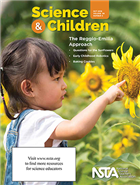Reggio Emilia inspiration in Science and Children
By Peggy Ashbrook
Posted on 2018-10-07
 The October 2018 issue of Science and Children has a concentration of articles on early childhood science learning inspired by the Reggio Emilia approach. (This emergent curriculum approach is described on page 37 and further explained in each article.) Children’s work described in this issue includes explorations of magnetism, solids and liquids, using heat to make a change (making cookies), creating videos about sunflowers, and defining “computer” based on their experiences and prior information learning. Wow, young children have wide interests!
The October 2018 issue of Science and Children has a concentration of articles on early childhood science learning inspired by the Reggio Emilia approach. (This emergent curriculum approach is described on page 37 and further explained in each article.) Children’s work described in this issue includes explorations of magnetism, solids and liquids, using heat to make a change (making cookies), creating videos about sunflowers, and defining “computer” based on their experiences and prior information learning. Wow, young children have wide interests!
Activities include using materials to represent weather events, using print and video resources to learn about animals’ use of their environment, investigating how water can move Earth materials and how glaciers can erode and transport them, and beginning coding. Children investigated how sunlight-warmed masonry walls stored and released heat, and sponges stored and released water, while investigating how glow-in-the-dark paint worked.
Lella Gandini, professor and U.S. Liaison for the Dissemination of the Reggio Emilia Approach on behalf of Reggio Children, Italy, says, “An essential element for positive learning and teaching in the Reggio Emilia approach is to view children and teachers as endowed with strong potential, ready to enter into relationships, ready to be listened to, and eager to learn. Once we value children and teachers this way, teaching cannot be done only through imparting information, but rather, it has to be an experience in which teachers and learners construct learning together.”
Using cycles of inquiry with iterations of wonder, engage, observe, and explore, and interpret, plan, and reflect, rather than “the scientific method,” articles in Science and Children emphasize how teachers and children construct learning together. Cheryl Paul notes that documentation of children’s work helped her reflect on her role as a partner in learning, and become aware of the children’s thought processes. This helped her in the design of explorations based on the children’s interests and/or investigations that would support further learning of the concept of magnetism. While baking cookies, children construct ideas about measurement and quantity as they developed their “cookie recipe.” Jane Broderick, Rebecca Aslinger, and Seong Bock Hong write about teachers documenting their thinking about children’s thinking as a basis for facilitating this children’s  inquiry. Children’s intuitive knowledge and understanding can emerge before any related direct teaching. Anne Lowry describes how finding answers to the questions her children pursued led them to asking new questions focused on related topics. The children reasoned about electricity as they investigated how electricity moves. In Lowry’s article you can follow the thinking of children as they move from one question to a related one. Educator-researchers Sohyun Meacham and Dana Atwood-Blaine gave children an introductory mini-lesson about robotics parts and devices to support planned possibilities. They then carefully listened to children’s conversations and asked probing questions, provided paper for blueprint drawing and discussed children’s ideas with them as they drew and built Lego robots. While learning how to use illustration and video skills to document and share their understanding of sunflowers (and the questions they would like to ask sunflowers) children at The College School in St. Louis were supported in their creative process.
inquiry. Children’s intuitive knowledge and understanding can emerge before any related direct teaching. Anne Lowry describes how finding answers to the questions her children pursued led them to asking new questions focused on related topics. The children reasoned about electricity as they investigated how electricity moves. In Lowry’s article you can follow the thinking of children as they move from one question to a related one. Educator-researchers Sohyun Meacham and Dana Atwood-Blaine gave children an introductory mini-lesson about robotics parts and devices to support planned possibilities. They then carefully listened to children’s conversations and asked probing questions, provided paper for blueprint drawing and discussed children’s ideas with them as they drew and built Lego robots. While learning how to use illustration and video skills to document and share their understanding of sunflowers (and the questions they would like to ask sunflowers) children at The College School in St. Louis were supported in their creative process.
The learning described in these articles blossoms through educators’ inspiration from Reggio Emilia to foster children’s creativity as they construct learning together.
Read more about emergent curriculum in “Inspired by Reggio Emilia: Emergent Curriculum in Relationship-Driven Learning Environments” in the November 2015 issue of Young Children.
Disclaimer: The views expressed in this blog post are those of the author(s) and do not necessarily reflect the official position of the National Science Teaching Association (NSTA).


